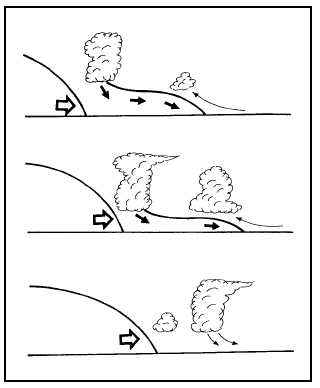fronts aloft can produce extensive cloud decks and
blizzard conditions for several hundred miles over the
mid western plains.
INSTABILITY AND SQUALL LINES
The terms instability line and squall line are
synonymous with violent winds, heavy rain, lightning,
thunder, hail, and tornadoes. The terms are often used
interchangeably and are incorrectly applied to any
severe weather phenomena that moves through a
region. However, there is a difference between an
instability line and a squall line.
Instability Line
An instability line is any nonfrontal line or band of
convective activity. This is a general term and includes
the developing, mature, and dissipating stages of the
line of convective activity. However, when the mature
stage consists of a line of active thunderstorms, it is
properly termed a squall line. Therefore, in practice, the
instability line often refers only to the less active
phases.
Squall Line
A squall line is a nonfrontal line or band of active
thunderstorms (with or without squalls). It is the
mature, active stage of the instability line. From these
definitions, instability and squall lines are air mass
phenomenon
because
they
are
both
nonfrontal
occurrences. However, they are frequently associated
with the fast-moving cold front.
NOTE:
The term instability line is the more
general term and includes the squall line as a special
case.
Prefrontal Squall Lines
A prefrontal squall line is a squall line located in
the warm sector of a wave cyclone. They form about 50
to 300 miles in advance of fast-moving cold fronts and
are usually oriented roughly parallel to the cold front.
They move in about the same direction as the cold front;
however, their speed is, at times, faster than the cold
front. You can roughly compute the direction and speed
by using the winds at the 500-mb level. Squall lines
generally move in the direction of the 500-mb wind
flow and at approximately 40% of the wind speed.
FORMATION.—There are several theories on the
development of prefrontal squall lines. A generally
accepted theory is that as thunderstorms develop along
the fast-moving front, large quantities of cold air from
aloft descend in downdrafts along the front and form a
wedge of cold air ahead of the front. The wedge of cold
air then serves as a lifting mechanism for the warm,
moist, unstable air; and a line of thunderstorms
develops several miles in advance of the front. Since the
thunderstorms form within the air mass and not along
the front, the squall line is considered as air mass
weather (fig. 4-34). In the United States, squall lines
form most often in spring and summer. They are
normally restricted to the region east of the Rocky
Mountains with a high frequency of occurrence in the
southern states.
WEATHER.—Squall-line
weather
can
be
extremely hazardous. Its weather is usually more severe
than the weather associated with the cold front behind
it; this is because the moisture and energy of the warm
air mass tends to be released at the squall line prior to
the arrival of the trailing cold front. Showers and
thunderstorms (sometimes tornadoes) occur along the
squall line, and the wind shifts cyclonically with their
passage (fig. 4-35). However, if the zone is narrow, the
wind shift may not be noticeable on surface charts.
There is generally a large drop in temperature because
of the cooling of the air by precipitation. Pressure rises
after the passage of the squall line, and, at times, a
4-36
SQUALL LINE DEVELOPMENT
AG5f0434
COLD
FRONT
DOWNDRAFTS
UNSTABLE
WARM AIR
COLD FRONT
DOWNDRAFTS
UNSTABLE
WARM AIR
SQUALL LINE
50 TO 100 MILES
COLD FRONT
Figure 4-34.—Prefrontal squall line development.


